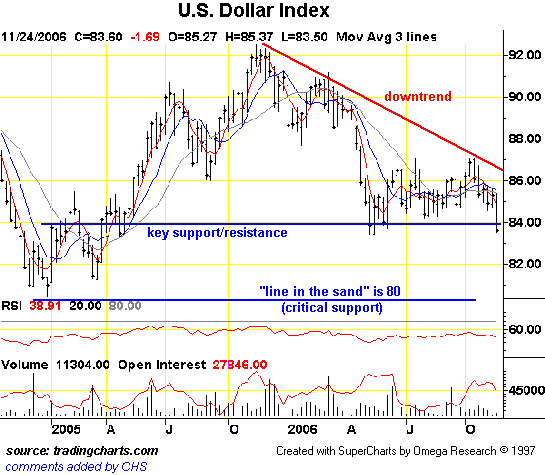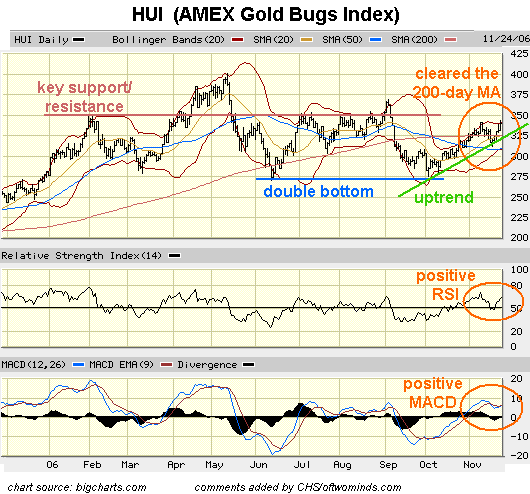

|
| weblog/wEssays archives | home | |
|
Beneath the Surface, Part I: The Dollar (November 27, 2006) Like many others who frequent this site, astute reader Jed H. has an interest not just in the bursting housing bubble but in all the moving parts which are intertwined with housing: the stock and bond markets, gold and the dollar. Jed was kind enough to send in links to three comprehensive, well-charted articles from safehaven.com: The Coming Collapse in Housing (11/17/06, by John Mauldin) Is the Dow Forked? (11/26/06, by Gary Tanashian) Death Knell of the US Dollar (11/26/06, by Clive Maund) Jed addressed one immediate topic of interest this way: Are the Dow Industrials & the S&P500 "topping out" from a Bear Rally, OR will this ~ 4 year rise from ~ 2003 go on more until spring 2007 ? Jed H.My own view is that "beneath the surface," the Dow and indeed the S&P 500 and the Nasdaq are all setting up for a very nasty, very sharp and very unexpected decline over the next few weeks. Rather than go directly to an analysis of the Dow (let's save that for later in the week), let's look at the dollar, which fell precipitously last week: 
Now maybe the dollar's descent was just a burp caused by light holiday trading, but before you accept that standard-issue complacency, take a look at gold as reflected in the HUI index: 
Note the many signs of technical strength in this chart: a successful re-test of lows (the classic double bottom), the rise in price above the 200-day moving average, the uptrend from the October low, and the RSI (relative strength) and MACD indicators in positive territory. It's also interesting that the HUI at 340 is a mere 10 points away from a critical level of support/resistance (350). If the index clears that hurdle then a move to previous highs and beyond would appear to be in the works. While gold and the dollar are not always on a see-saw--when one is up, the other is down--it is rather obvious that the dollar's last peak occurred in early October, just as gold hit its nadir. A vast army of analysts have pointed out that 80 is the key support level for the dollar, going back to the late 70s. There will of course be a defense in depth of that support, for if the dollar breaks decisively through 80, there is no bottom in sight. So what factors are at play in the dollar's decline? The standard line at the moment is that the Eurozone's central bank is poised to raise interest rates, just as the consensus (i.e. sure to be wrong) in the U.S. is solidifying around the idea that the Fed will lower the Fed Funds Rate in a matter of months. But there may be other forces at work beneath the surface--for instance, a divergence between China and the other massive buyers of U.S. debt and dollars. The standard consensus holds that China ($800 billion in dollar reserves), Japan ($700 billion in dollar reserves) and the oil exporting nations of the Gulf (uncounted billions in dollar reserves via London and offshore Caribbean banks) have all been propping up the dollar with stupendous purchases of U.S. Treasury bonds in order to keep the foolish American consumer spending freely on OPEC, Chinese and Japanese exports. While there is an undeniable logic to that, it is also true that a weakening dollar actually benefits China in a way that it does not benefit Euroland, OPEC or Japan. Since the yuan is pegged to the dollar, as the dollar plummets, so too does the yuan, making both American and Chinese exports ever cheaper in Japan and Europe. From China's point of view, what's not to like? Sure, their dollar reserves drop in value, but the name of the game for the Party leadership is jobs--as in creating tens of millions of them to provide incomes to tens of millions of restive peasants fleeing rural poverty. So if their dollar reserves drop in value by $100 billion or so, that is a small price to pay for extending their exports to Europe and Japan--two huge markets with which they currently run trade deficits. Japan, Euroland and OPEC, meanwhile, will be hurt by a plummeting dollar. Since oil is priced in dollars, a 20% drop in the value of the dollar means OPEC receives 20% less value for every barrel of oil they sell in terms of non-U.S. currencies. Japan and Euroland still depend very heavily on exports to the U.S. to prop up their own economies, so a drop in the dollar is most unwelcome, as it immediately raises the cost of their goods to the U.S. consumer. To maintain their market share, they'll have to slash their profit margins--also not a happy thought. You've undoubtedly read how top Chinese bankers keep talking about the risks of holding too many dollars and U.S. bonds. Read between the lines, these cautioning statements are actually akin to loud shouting: "We're not going to support the dollar any longer!!" And why should they? If the dollar drops to 80 or under, then China's exports to Europe and the rest of Asia just got cheaper in those markets. And since the yuan is pegged to the dollar, Chinese goods exported to the U.S. are unaffected by the decline in the dollar. A drop in the dollar can only boost Chinese exports--a very welcome prospect to a nation seeking to create 30-40 million jobs a year. As gold tracks a strongly bullish uptrend, it's something to ponder. Disclosure: I own calls on gold and puts on the DJIA. This is a disclosure, not advice. Note: I may be horribly wrong about everything. I offer no recommendation other than this: do not buy or sell securities based on what others recommend or don't recommend. Do your own analysis and make your own decisions. For more on this subject and a wide array of other topics, please visit my weblog. copyright © 2006 Charles Hugh Smith. All rights reserved in all media. I would be honored if you linked this wEssay to your site, or printed a copy for your own use. |
||
| weblog/wEssays | home |